Excitable tissue - Study guides, Class notes & Summaries
Looking for the best study guides, study notes and summaries about Excitable tissue? On this page you'll find 369 study documents about Excitable tissue.
Page 2 out of 369 results
Sort by
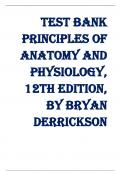
-
Test Bank Principles of Anatomy and Physiology, 12th Edition, by Bryan Derrickson, Gerald Tortora | Complete Guide A+
- Exam (elaborations) • 748 pages • 2023
-
- $17.99
- 1x sold
- + learn more
Test Bank Principles of Anatomy and Physiology, 12th Edition, by Bryan Derrickson, Gerald Tortora Testbank Chapter 1. An Introduction to the Human Body Multiple Choice 1. This is the study of the functions of body structures. a. Anatomy b. Physiology c. Dissection d. Histology e. Immunology Ans: B Difficulty: easy Feedback: 1.1 2. This is defined as a group of cells with similar structure and function. a. Tissue b. Organ c. Molecules d. Compounds e. Organism Ans: A Difficulty: easy Feedback: 1.2...
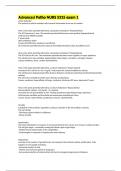
-
Advanced Patho NURS 5315 exam 1
- Exam (elaborations) • 19 pages • 2024
-
- $11.50
- + learn more
Advanced Patho NURS 5315 exam 1 action potential The process by which excitable cells transmit information from one to another. How is the action potential altered by a potassium imbalance? (Hyperkalemia) The ECF has more K+ ions. The membrane potential becomes more positive (hypopolarized). Cells become MORE excitable. T waves peak. QRS complexes widen. Causes dysrhythmias, weakness, paresthesia. {If membrane potential becomes equal to threshold potential cardiac standstill occurs}...
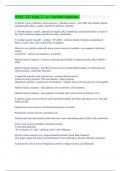
-
ANSC 423 Quiz 2 || A+ Verified Solutions.
- Exam (elaborations) • 13 pages • 2024
- Available in package deal
-
- $11.09
- + learn more
3 Distinct Types of Muscle correct answers 1. Skeletal muscle ~ 40% BW, has striated, tubular multinucleated fibers, usually attached to skeleton, voluntary 2. Smooth muscle- narrow, atpered rod shaped cells, nonstriated, uninucleated fibers, occurs in the walls of internal organs and blood vessles, involuntary 3. Cardiac muscle (smooth + cardiac= 10% BW) - striated, tubular, branches, uninucleated fibers, occurs in the walls of the heart, involuntary Muscle is an excitable contractil...
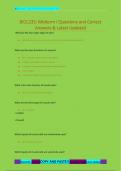
-
BIOL235: Midterm I Questions and Correct Answers & Latest Updated
- Exam (elaborations) • 64 pages • 2024
-
- $13.79
- + learn more
What are the four major types of cells? o :## Neurons (nervous), muscle, epithelial, and connective tissue cells What are the main functions of a neuron? o :## > Rapidly transmits electrical signals o > Highly branched to send or receive o > Enables communication between the brain and o other organs o > Processes simple and complex information What is the main function of muscle cells? o :## > Contract and generate force What are the three types of muscle cells? o :#...

-
APHY 101 Ch 1: An Introduction to the Human Body Ivy Tech Latest 2024 Graded A+
- Exam (elaborations) • 12 pages • 2024
- Available in package deal
-
- $9.99
- + learn more
APHY 101 Ch 1: An Introduction to the Human Body Ivy Tech Latest 2024 Graded A+ Anatomy Studies the structure of body parts and their relationships to one another. Physiology Concerns the function of the body, in other words, how the body parts work and carry out their life sustaining activities. Often focuses on cellular and molecular level. Gross or Macroscopic Anatomy Study of large body structures visible to naked eye (ex: heart, lungs, kidneys). Regional Anatomy All structures in a particul...
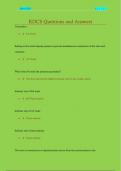
-
RDCS Questions and Answers
- Exam (elaborations) • 52 pages • 2024
- Available in package deal
-
- $13.49
- + learn more
Pacemaker o :# SA Node Backup to SA node Impulse pauses to prevent simultaneous contraction of the atria and ventricles o :# AV Node Why is the SA node the primary pacemaker? o :# The SA node has the highest intrinsic rate of any cardiac tissue Intrinsic rate of SA node o :# 60-70 per minute Intrinsic rate of AV node o :# 50 per minute Intrinsic rate of myocardium o :# 30 per minute The wave of contraction or depolarization moves from the endocardium to the 2024/2025 2 | P a g e ...
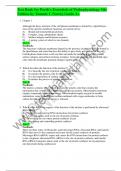
-
Test Bank for Porth's Essentials of Pathophysiology 5th Edition by Tommie L Norris| Guide A+
- Exam (elaborations) • 537 pages • 2023
-
- $24.99
- 1x sold
- + learn more
Test Bank for Porth's Essentials of Pathophysiology 5th Edition by Tommie L Norris Test Bank for Porth's Essentials of Pathophysiology 5th edition by Tommie L Norris 1. Chapter 1 Although the basic structure of the cell plasma membrane is formed by a lipid bilayer, most of the specific membrane functions are carried out by: A) Bound and transmembrane proteins B) Complex, long carbohydrate chains C) Surface antigens and hormone receptors D) A gating system of selective ion channels Feedback: Th...
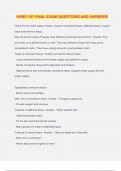
-
HUBS 191 FINAL EXAM QUESTIONS AND ANSWERS
- Exam (elaborations) • 119 pages • 2024
-
- $14.49
- + learn more
HUBS 191 FINAL EXAM QUESTIONS AND ANSWERS Name the four basic types of tissue -Answer-Connective tissue, epithelial tissue, muscle tissue and nervous tissue. Why do the four types of tissues have different structures and function? -Answer-They are made up of different kinds of cells. They have different things that make up the extracellular matrix. They have varying amounts of extracellular matrix. Types of connective tissue -Answer-Connective tissue proper - Loose connective tissue which...
![PNS: EXAM 1 REVIEW QUESTIONS AND ANSWERS, GRADED A+[LATEST EXAM UPDATES]](/docpics/5653779/666f3ebbcf9cd_5653779_121_171.jpeg)
-
PNS: EXAM 1 REVIEW QUESTIONS AND ANSWERS, GRADED A+[LATEST EXAM UPDATES]
- Exam (elaborations) • 26 pages • 2024
-
- $10.49
- + learn more
PNS: EXAM 1 REVIEW QUESTIONS AND ANSWERS, GRADED A+ what does the nervous system do for the body? - --enables it to react to continuous changes in its internal and external environments -also controls and integrates the various activities of the body such as circulation and respiration structurally, the nervous system is divided into what? - -CNS and PNS functionally, the nervous system is divided into what? - -somatic nervous system (SNS) and autonomic nervous system (ANS) what ar...
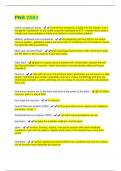
-
PNB 2XB3 QUESTIONS & ANSWERS GRADED A+
- Exam (elaborations) • 36 pages • 2024
- Available in package deal
-
- $9.69
- + learn more
sodium potassium pump - ️️enzyme that transports 3 sodium to the outside, and it transports 2 potassium to the inside using the hydrolysis of ATP - creates more sodium outside and more potassium inside and creates a concentration gradient Midline, ipsilateral and contrelateral - ️️line separating left and right of the entire nervous system - ipsilateral means the same side of something and contralateral means the opposite side of something Nissl stain showed (Nissl) - ️️Nissl u...

That summary you just bought made someone very happy. Also get paid weekly? Sell your study resources on Stuvia! Discover all about earning on Stuvia


